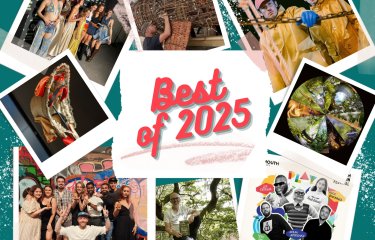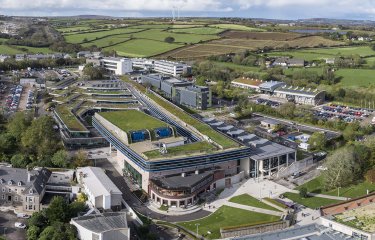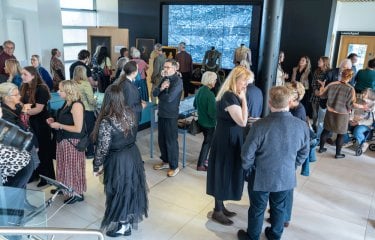Filmmaking for Galapagos Conservation
19 March 2020
Remote sun-baked islands, turquoise seas, wildlife you can’t find anywhere else in the world – it sounds like paradise. University staff and students have been visiting the Galapagos Islands for the past 5 years to photograph and film the beautiful nature and wildlife. But it’s not all gentle strolls on the beach and sunbathing for them!
Marine & Natural History Photography staff have established close relationships over the years, getting involved with research projects alongside the Galapagos Conservation Trust (GCT) and Charles Darwin Foundation (CDF), a leading scientific research team.
This collaboration enables staff and students to gain access to parts of the Galapagos Islands that other visitors are not allowed to go.
Marine & Natural History Photography Lecturer and organiser of the trip Joanna Henley tells us, “It’s hot, busy and hard work. Daily expeditions, getting to and from the remote locations, dealing with unpredictable nature and having the patience to wait to get the right shots are all challenging. But at the same time it’s a complete privilege!”
Each year, a team of fifteen (staff and students) have been given special access to the islands’ habitat and wildlife, on land and underwater, which in turn helps the GCT and CDF to raise awareness of their research projects and the conservation issues facing the islands.
Student Sam Whitton was selected to go to the Galapagos on the most recent trip. He said, “Visiting the Galapagos has been the most incredible experience of my life. It’s a part of the world unlike any other, teeming with species found only here. I never dreamed I’d be lucky enough to visit such a special place - let alone be granted access like we had! We visited areas of the National Park closed to tourists and were able to document the pioneering science being conducted by inspiring researchers on the frontline of conservation here.
“We delved into the issue of invasive species that are threatening the native ecosystem. This was not only fascinating, but hugely important. The film we produced for the Charles Darwin Foundation is now being used to educate schools and locals on the islands.
“Producing a professional film for an incredible organisation was an enormous privilege. I had so much fun exploring these remarkable islands, which has fuelled my aspirations to become a wildlife filmmaker. I’ll never forget it.”
The most recent visit focussed on saving endemic land birds on the Galapagos – such as the vermillion flycatcher, and the finches and mockingbirds fondly known as ‘Darwin’s birds’ following Charles Darwin’s visit to the islands in 1835.
Joanna continues, “These birds do not exist anywhere else in the world. If lost on the Islands they will become extinct.
“They are under threat from a fly - Philornis downsi – the flies lay eggs in bird’s nests, the fly eggs become larvae that then attach to and feed on baby birds in the nest, causing them to die.
“The GCT and CDF are working together to find a solution to reduce the number of flies and to save the endemic land birds.
“On our last visit, the students created a wonderful film to raise awareness of this parasite and to ask for support in combating this threat. It’s been the most successful film yet; it premiered at Galapagos Day in London, has been shown in schools and is used by the CDF in their visitor centre.”
Student Charles Cupples shared how the trip has fed his passion for conservation, “I’ve always dreamt of visiting the Galápagos Islands. So, when I was informed that I had been selected to be part of the team embarking on the 2019 Falmouth Galápagos expedition it really was a dream come true.
“The two weeks spent shooting in what is the most diverse ecosystem on the planet was a once in a lifetime experience. Along with having the opportunity to observe the behaviour of some of the archipelago’s endemic species, the trip provided pivotal information on localised and worldwide conservation issues. It also gave me a clearer understanding on the changes that need to be made in order to preserve this habitat.
This incredible opportunity developed my passion for conservation. It has increased my determination to document this vulnerable environment and do my part to help protect the Galápagos Islands and educate future generations.”
Lecturer, Joanna added, “The visit links nicely with the course, the students would have just completed their module in conservation before they travelled. While they are there, students and staff also have the opportunity to give back to the islands.
“We run photographic workshops to teach young locals to photograph and appreciate the wildlife and we have donated camera equipment to support them in maintaining this involvement with nature. We are so pleased to be able to get involved in conservation in such a beautiful part of the world, and to enable our students to have such special access to these remote islands and this unique wildlife.”
If you’re lucky enough to be on the islands, visit The Charles Darwin Foundation and check out the ‘Falmouth Wall’ – a constant exhibition which has been updated each year with stunning photos from the university trip.
Student Emily Kennett has one of her images up on the Falmouth Wall from the most recent trip. She told us, “The islands of Galapagos are iconic in natural history, and so it was a real privilege to have the opportunity to go with the University and we all had a really incredible time.
“Making the film whilst out there brought the Falmouth team really close together. It was a harrowing subject about a small invasive fly decimating the endemic population of land birds. Even though a lot of planning went into the film, there was a lot of pressure to get things right as a lot of the time we only had one chance to get the shot. We were all there to support each other though, so we ended up with a really informative and emotive film.
“We did a lot of things whilst out there, and no time was wasted. I think we managed to see nearly every animal that we were hoping for throughout the trip, and so there was a lot of positive energy in the team. From birds and insects to fish and reptiles, there was stuff to see everywhere – and that was so exciting as most of what you see out there can be found no-where else on earth.”
Check out the film below.
Photos by Emily Kennett, Sam Whitton and Charles Cupples.




